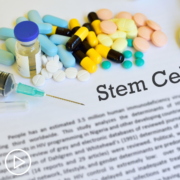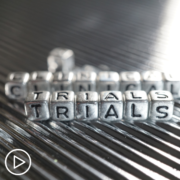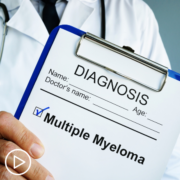Myeloma Combination Therapy | What Patients Should Know
Myeloma Combination Therapy | What Patients Should Know from Patient Empowerment Network on Vimeo.
Expert Dr. Jeffrey Matous shares an overview of myeloma treatment classes, why combination therapy can be effective, and the importance of clinical trials in patient care and moving research forward.
Dr. Jeffrey Matous is a myeloma specialist at the Colorado Blood Cancer Institute and the assistant chair in myeloma research for Sarah Cannon Research Institute. Learn more about Dr. Matous.
Related Resources:

|

|
Transcript:
Katherine:
There are several treatment classes for myeloma, such as immunomodulatory therapy and proteasome inhibitors, for example, and they’re often used together. So, what is a combination therapy and why is it used so frequently for myeloma?
Dr. Jeffrey Matous:
Absolutely, so with learned over the years in myeloma that combining different types of drugs that work in different ways, we call those classes, so different classes of drugs, combining them together is the optimal treatment for myeloma.
And back in the day, we used to use two drugs. Then, we learned that three drugs are better than two drugs, and now, we have data that four drugs are better than three drugs. And so, we bring in drugs from all kinds of different categories for our patients. And we even know that for the non-transplant-eligible patients, for the older patients, for example, that combining drugs from different classes is really, really important to get the best outcomes. And in general, the three classes that we use – the four classes that we use when we’re treating myeloma patients initially include the immunomodulatory drugs, and examples of those are lenalidomide, also called Revlimid. pomalidomide, also called Pomalyst. Thalidomide’s (Thalomid) an older drug, but we still occasionally use it.
And then, we have the proteasome inhibitors. Examples of those are bortezomib (Velcade), carfilzomib (Kyprolis), and to a much lesser extent, there’s one called ixazomib (Ninlaro). And these days, we know that CD38 antibodies are really important and really getting their foothold into the initial treatment of myeloma.
Examples of CD38 antibodies are daratumumab (Darzalex) or isatuximab. And then, usually, we combine these treatments with steroid medicines to sort of increase the effectiveness of the regimens. That’s how – those are the classes that we use when we’re treating myeloma.
Katherine:
Okay and have you learned about adding one treatment to another to another through clinical trials or is trial and error?
Dr. Jeffrey Matous:
Absolutely. We would not be where we are right now without the conduct of clinical trials. I always tell my patients by the time something’s approved in myeloma, and we had things approved in 2022, the field is already moving past that in clinical trials. It’s unbelievable. So, I’ll give you an example. When daratumumab, one of these antibodies, got approved by the FDA, already when it got approved by the FDA, we knew through clinical trials that were being conducted that combining it with other types of medicines was far more potent.
And we have countless examples of this, so yeah. Absolutely, so every treatment that we use in myeloma, we discovered and developed through a clinical trial. And I always encourage my patients strongly to consider clinical trials, and then, we have to explain, because when patients hear clinical trials, and I could be deviating a little bit here, Katherine.
They often think about experimentation and testing things that are unproven. In myeloma, we occasionally do that, but far and away, the overwhelming majority of our clinical trials are testing agents that we know are effective. We’re just trying to figure out what the best combination is and make sure that it’s safe for patients.




















